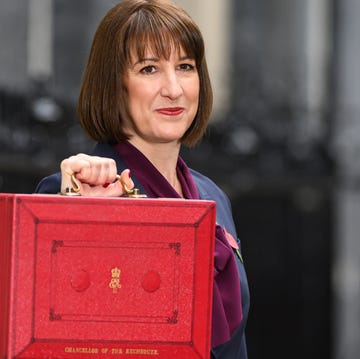Over the past year, the interest rate on savings accounts has been steadily rising, thanks to Bank of England base rate increases. However, at the same time, soaring inflation means the spending power of our savings is constantly being eroded. So what can you do to give your savings a boost? Here are 9 smart money moves to make right now.
1. Move your money
It’s unlikely your old savings accounts are still paying you a competitive rate. Just moving your money into a best-buy account can make a huge difference to the returns you get.
"Many of the best rates on offer are paying more than they have for over a decade," says Anna Bowes, co-founder of Savings Champion. "So savers who are prepared to shop around can earn some meaningful interest on their hard-earned savings."
What to read next
For example, 18 months ago the best rate on an easy-access account was 0.33%. Now, Chip is offering 3.15% on its easy access account (with unlimited withdrawals). On a £5,000 balance, that is a difference of £141 a year. If you’re already with Barclays and a member of its Blue Rewards scheme, you can open a new Rainy Day Saver account, which pays 5.12% interest up to £5,000.
To get the very best rates, you need to be prepared to consider banks you may not have heard of. "Some high-street banks are still paying the lowest rates," says Bowes. "Savers should make sure they know the rate of interest they are earning and switch if it’s not competitive." The average rate of interest offered by the big banks’ easy-access savings accounts is currently just 1.5%, according to Savings Champion. Digital bank Monzo has just launched its first ever Instant Access Savings Pot, with a 3% AER variable rate.
Make sure the bank you move to is covered by the Financial Services Compensation Scheme (fscs.org.uk/check-your-money-is- protected). That means up to £85,000 is guaranteed to be returned to you if the bank collapses.
2. Split your money
Keeping all your money in an instant-access account means you are missing out on the higher rates offered on fixed-rate bonds.
"There’s always a concern that if you lock into a fixed-rate bond today, you might miss out on better rates tomorrow," says Bowes. "That’s a risk you may have to take. However, if you’re waiting for something better to come along while leaving your cash to languish in a poorer-paying account, you’ll be missing out on earning that bit more."
Having said that, with interest rates still rising, this isn’t the time to lock your money away for five years. Do that, and when rates rise again, you could be left with your money trapped in an uncompetitive account.
The good news is the interest rates offered on one-year bonds are at a 13-year high. For example, you can earn 4.26% with Smart Save’s one-year bond. Combine that with a best-buy instant-access account and you’ll know you’re getting the best possible returns on all of your cash.
3. Use notice accounts to boost your returns
If you don’t need instant access to your cash but don’t want to lock it away for a year either, another option is a notice account. These will give you an increased return compared to an easy-access account, depending on how much notice you’re prepared to give before you access your money. Options vary from 30 days to 180.
4. Protect your savings from tax
Recently, returns on savings have been so pitiful most of us didn’t need to worry about the tax office taking a share, but that may change. Basic-rate taxpayers can earn up to £1,000 a year in interest tax-free. After that you pay 20% of the interest you earn to the tax office. That £1,000 is known as your Personal Allowance. If you are a higher-rate taxpayer, you get a £500 Personal Allowance, then pay tax at 40% on your interest. Additional rate taxpayers get no Personal Allowance.
As interest rates rise, the prospect of breaching your allowance is more likely. A higher rate taxpayer with £12,000 in the best-buy one-year bond would earn over £511 interest, for example.
But there is a way to avoid giving any of your hard-earned interest to the tax office: keep your money in an Individual Savings Account (ISA). You can deposit up to £20,000 into an ISA each tax year and it can then grow tax-free for as long as it remains in the account.
The best instant-access ISA rate is 3.01% from Shawbrook Bank; you could increase that to 4.25% from Virgin Bank for the best one-year ISA. Rates are slightly lower than you can get in non-ISA accounts, so only opt for an ISA if you are at risk of breaching your Personal Allowance.
5. Be Proactive
Maximising the returns on your savings isn’t a one-time activity. "It’s vital that savers do not become apathetic and instead are proactive to chase down a better deal, especially as there are easy-access accounts paying as little as 0.1%," says Rachel Springall from MoneyFacts.co.uk.
Once you’ve moved your money into the best easy-access account and fixed-rate accounts, make a note in your diary for six months’ time to check the rates again. "Keeping a close eye on the top rate and signing up to rate alerts is essential to avoid the disappointment of missing out," says Springall. "It is expected that we will see even more base-rate rises this year and if providers fail to pass this on, savers would be wise to reconsider their loyalty and switch."
With fixed-term bonds, make a note of when your account matures and shop around for the best new home for your cash. Fail to move your money when your bond matures, and your provider is likely to move the money into a new account paying a pitiful interest rate. Take Nationwide’s one-year bond, which pays a very competitive 3.75%; after 12 months your money will be moved into an instant-access savings account, which is currently paying just 0.75% interest.
6. Save regularly (ish)
Some of the best returns around right now are offered on regular savings accounts. These accounts limit how much you can deposit monthly (typically between £10 and £500). One of the best rates at the moment is offered by NatWest Digital Regular Saver, which is paying 6.17% annually on up to £5,000 (maximum monthly deposits of £150; 0.65% paid on portion over £5K).
These accounts are a great way to build up a nest egg, but you can also take advantage even if you have already built up some savings. Simply open a regular savings account and move the maximum amount from your easy-access savings account each month.
7. Squirrel away your cash
Boost your savings via cashback cards and websites and add to your account.
If you can pay off your credit card balance in full each month, a cashback credit card will reward you. The American Express Platinum Cashback Everyday card will give you back 5% of what you spend for the first three months, up to £100; after that, it’s 0.5% on the first £10,000 of annual spending and 1% on over £10,000. The cashback is paid once a year, usually as a credit on your account balance, so it’s knocked off your bill. Make a note of when it is paid and move the amount you would have spent on that month’s credit card bill into your savings account.
Just make sure you pay off your balance in full each month, or you’ll be charged a whopping 33.6%APR.
You can also earn cashback via websites such as Quidco or TopCashback: 3% cashback at Net-A-Porter via Quidco or £37 from TopCashback if you use Go.Compare to shop for home insurance. Once the cashback is available to you, move it into your savings account.
8. Grab current account switching bonuses
A great way to give your savings pot a helping hand is to regularly change current accounts and grab the switching bonuses banks pay to new customers. Right now, you could get £200 for switching to a NatWest and Royal Bank of Scotland current account. You just need to switch and pay in £1,250 within 60 days. You should then receive £200 within 10 days.
Alternatively, you could get £175 from First Direct. Put the switching bonus into your savings account and you can give your nest egg a healthy boost.
9. Try Help to Save
If someone you know is on a low income or certain benefits, make sure they know about the Government’s Help to Save scheme. It’s run with National Savings & Investments (NS&I) and you can pay between £1 and £50 into the account every month for up to four years. Savers won’t earn any interest, but at the end of two years and again at four years, the Government will add a bonus that amounts to 50% of the highest balance throughout the previous two years. If, as an example, you save £50 each month, after two years you would have a balance of £1,200 – so the Government would add a tax-free bonus of £600. Carry on saving £50 a month and after four years you would get another £600, and you’d have built a nest egg worth £3,600. Withdrawals can be made from the account at any time.
You can apply for a Help to Save account if you receive Working Tax Credit, Child Tax Credit or are claiming Universal Credit and earned at least £658.64 from paid work in your last monthly assessment.
NEXT STEP… INVESTING?
When inflation is eating away at your cash savings, your investments become more important than ever. Find out how to get started with investing using The GH guide to growing your money.
If you'd like more great money reads, SIGN UP HERE for our fortnightly Financially Fabulous newsletter!














